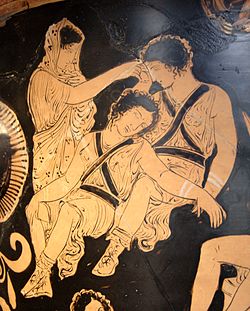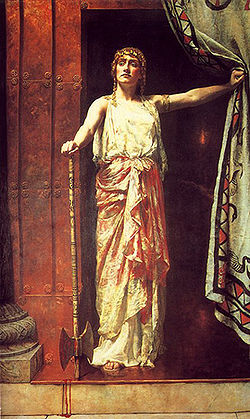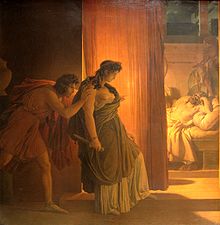- Clytemnestra
-
Clytemnestra or Clytaemnestra (pronounced /ˌklaɪtəmˈniːstrə/; Greek: Κλυταιμνήστρα, [klytai̯mnɛ̌ːstra]), in ancient Greek legend, was the wife of Agamemnon, king of the Ancient Greek kingdom of Mycenae or Argos. In the Oresteia by Aeschylus, she was a femme fatale who murdered her husband, Agamemnon – said by Euripides to be her second husband – and the Trojan princess Cassandra, whom he had taken as war prize following the sack of Troy. However, in Homer's Odyssey, her role in Agamemnon's death is unclear and her character is significantly more subdued.
The name form Κλυταιμνήστρα (Klytaimnēstra) is commonly glossed as "famed for her suitors". However, this form is a later misreading motivated by an erroneous etymological connection to the verb μναoμαι 'woo, court'. The original name form is believed to have been Κλυταιμήστρα (Klytaimēstra), without the -mn-, and the modern form with -mn- does not occur before the middle Byzantine period.[1] Aeschylus, in certain wordplays on her name, appears to assume an etymological link with the verb μήδoμαι, 'scheme, contrive'.
Background
Clytemnestra was the daughter of Tyndareus and Leda, the king and queen of Sparta. According to the myth, Zeus appeared to Leda in the form of a swan, seducing and impregnating her. Leda produced four offspring from two eggs: Castor and Clytemnestra from one egg, and Helen and Polydeuces from the other. Therefore, Castor and Clytemnestra were fathered by Tyndareus, whereas Helen and Polydeuces were fathered by Zeus.
Agamemnon and his brother Menelaus were in exile at the home of Tyndareus. In due time the brothers married Tyndareus' two daughters: Agamemnon marrying Clytemnestra and Menelaus marrying Helen. In a late variation, Euripides's Iphigenia at Aulis, Clytemnestra's first husband was Tantalus, King of Pisa (in the western Peloponnese), who was slain by Agamemnon. Agamemnon also murdered her infant son. He then forcibly made Clytemnestra his wife. In another version, her first husband was King of Lydia, which was known to the Greeks for its shrine of the labrys, the double-bladed ax that some say Clytemnestra used to kill Agamemnon.
With the help of troops from his new father-in-law, Agamemnon then took the throne of Mycenae from his uncle Thyestes. Agamemnon and Clytemnestra became rulers of Mycenae, and she bore three daughters: Iphigenia, Chrysothemis, and Electra; and finally a son: Orestes (Chrysothemis is sometimes not included, and Iphigenia has several stories of who her parents are).
Mythology
After Helen went (or was taken) from Sparta to Troy, her husband, Menelaus, asked his brother Agamemnon for help. Greek forces gathered at Aulis. However, consistently weak winds prevented the fleet from sailing. Through a subplot involving the gods and omens, the priest Calchas said the winds would be favorable if Agamemnon sacrificed his daughter Iphigenia to the goddess Artemis. Agamemnon persuaded Clytemnestra to send Iphigenia by deceptively telling her that the purpose of his daughter's visit was to marry her to Achilles. When Iphigenia arrived at Aulis, she was sacrificed, the winds turned, and the troops set sail for Troy. Clytemnestra learned of this event and grieved for her daughter.
The Trojan War lasted ten years. During this period of Agamemnon's long absence, Clytemnestra began a love affair with Aegisthus, her husband's cousin. Whether Clytemnestra was seduced into the affair or entered into it independently differs according to the respective author of the myth. Nevertheless, Clytemnestra, enraged by Iphigenia's murder (and presumably the earlier murder of her first husband by Agamemnon, and her subsequent rape and forced marriage), and Aegisthus, whose father Thyestes was horribly betrayed by Agamemnon's father Atreus, and who was conceived specifically to take revenge on that branch of the family, began plotting Agamemnon's demise.
In old versions of the story, on returning from Troy Agamemnon is murdered by Aegisthus, the lover of his wife Clytemnestra. In some later versions Clytemnestra helps him or does the killing herself in his own home. The best known version is that of Aeschylus: having arrived at his palace with his concubine, the Trojan princess Cassandra in tow and being greeted by his wife, he entered the palace for a banquet while Cassandra remained in the chariot. Clytemnestra waited until he was in the bath, and then entangled him in a cloth net and stabbed him. Trapped in the web, Agamemnon could neither escape nor resist his murderer. In some versions Cassandra has twin sons by Agamemnon (whether Clytemnestra was jealous of Cassandra is unknown. It was quite normal at the time for men to take concubines, usually acquired as war prizes, when on campaign).
Meanwhile, Cassandra saw a vision of herself and Agamemnon being murdered. Her attempts to elicit help failed (she had been cursed by Apollo that no one would believe her prophecies). She realized she was fated to die, and resolutely walked into the palace to receive her death.
After the murders, Aegisthus replaced Agamemnon as king and ruled for seven years with Clytemnestra as his queen. In some traditions they have three children: a son Aletes, and daughters Erigone and Helen. Clytemnestra was eventually killed by her own son Orestes. The infant Helen is also killed. Aletes and Erigone grow up at Mycenae, but when Aletes comes of age, Orestes returns from Sparta, kills his half-brother, and takes the throne. Orestes and Erigone are said to have had a son, Penthilus.
Clytemnestra's personality differs between tellings, as weak and submissive (Homer's Clytemnestra), or ruthless and manipulative (Aeschylus' Clytemnestra). This affects her role in the affair with Agamemnon.
 Orestes Pursued by the Furies by William-Adolphe Bouguereau. Clytemnestra was murdered by Orestes and the Furies torment him for his crime
Orestes Pursued by the Furies by William-Adolphe Bouguereau. Clytemnestra was murdered by Orestes and the Furies torment him for his crime
Clytemnestra has been the subject of many artistic works.
- She is one of the main characters in Aeschylus's Oresteia, and is central to the plot of all three parts. She murders Agamemnon in the first play, and is murdered herself in the second. Her death then leads to the trial of Orestes by a jury composed of Athena and 11 Athenians in the final play.
- The American modern dancer and choreographer Martha Graham created a two-hour ballet, Clytemnestra (1958), about the queen.
- Most recently, playwright/actor Corey Allen wrote a contemporary adaptation of Aeschylus' earlier work entitled Clytemnestra.
- The story has also been adapted into an opera; Cromwell Everson a South African composer wrote the first Afrikaans opera, "Klutaimnestra", in 1967. It is an opera in four acts and premiered on November 7, 1967 in Biesenbach Hall, Worcester, Western Cape, South Africa.
- Clytemnestra Sutpen was the daughter of Thomas Sutpen and his negro slave in William Faulkner's work Absalom, Absalom!
- John Eaton composed an opera in one act entitled The Cry of Clytemnestra recounting the events leading up to and including Clytemnestra's murder of Agamemnon.
- Ismail Kadare in his novel The Successor draws upon the Clytemnestra myth while sardonically commenting on the political climate of communist Albania.
References
- ^ "Oresteia", Loeb edition by Alan Sommerstein, intro, p.x, 2008.
- Servius. In Aeneida, xi.267.
Categories:- Greek mythology
- Women in Greek mythology
- Greek regicides
- Mycenae
Wikimedia Foundation. 2010.



